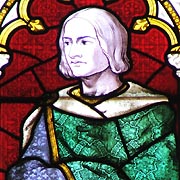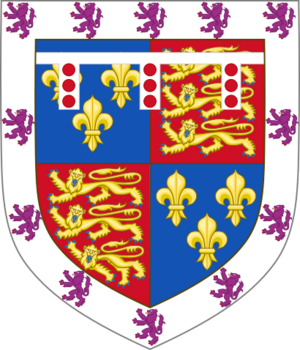Richard of Conisburgh, 3rd Earl of Cambridge facts for kids
Quick facts for kids Richard of Conisbrough |
|
|---|---|
| Earl of Cambridge | |
 |
|
| Predecessor | Edward, 2nd Duke of York |
| Born | 20 July 1385 Conisbrough Castle, Yorkshire, England |
| Died | 5 August 1415 (aged 30) Southampton, Hampshire, England |
| Spouse | Anne Mortimer (1408, d. 1411) Maud Clifford (after 1411) |
| Issue more... |
|
| House | York |
| Father | Edmund, 1st Duke of York |
| Mother | Isabella of Castile |
| Religion | Roman Catholicism |
Richard of Conisbrough, 3rd Earl of Cambridge (born 1385 – died 1415) was an English nobleman. He was the second son of Edmund of Langley, 1st Duke of York, and Isabella of Castile, Duchess of York. Richard was involved in a plot against King Henry V and was executed for it. He was an important ancestor of two future kings of England: King Edward IV and King Richard III.
Contents
Who Was Richard of Conisbrough?
Richard of York was born around July 20, 1385, at Conisbrough Castle in Yorkshire, England. His father was Edmund of Langley, the first Duke of York. His mother was Isabella of Castile.
Richard's grandparents on his father's side were King Edward III and Philippa of Hainault. On his mother's side, his grandfather was Peter the Cruel, who was King of Castile and León.
King Richard II was Richard's godfather. This means King Richard II was a special person who promised to help guide Richard's life.
Richard was 12 years younger than his older brother, Edward. It's interesting that Richard didn't inherit any land or money from his father. This has led some historians to wonder about his family background.
How Did Richard Get His Income?
Even though his father didn't leave him anything, Richard's mother, Isabella, made sure he was taken care of. Before she died in 1392, she asked King Richard II to give her younger son some money each year.
The king agreed. In 1393, he gave Richard an annual payment of £100 from lands in Yorkshire. He also gave him another payment of £233 from the royal treasury. This money was Richard's main source of income.
However, King Richard II was removed from power in 1399. The new king, Henry IV, did not favor Richard. This meant Richard's payments were often late or sometimes didn't come at all.
What Military Service Did Richard Perform?
From 1403 to 1404, Richard led a small group of soldiers. Their job was to defend Herefordshire against a Welsh rebel leader named Owain Glyndŵr. This was his only major military role.
In 1406, Richard was chosen for an important diplomatic mission. He helped escort King Henry's daughter, Philippa, to Denmark. She was going there to marry King Eric. Richard was knighted, meaning he became a knight, before this trip.
During this journey, Richard became good friends with Lord Scrope. Years later, they would both be involved in a serious plot against the king.
The Southampton Plot
In 1414, Richard was given the title of Earl of Cambridge. This title had belonged to his older brother, Edward, before. However, becoming an Earl did not come with any land or money for Richard. This made him one of the poorest Earls.
Because he lacked money, Richard struggled to prepare for King Henry V's planned invasion of France. This might have been one reason why he joined a secret plan.
Richard, along with Lord Scrope and Sir Thomas Grey, planned to remove King Henry V from power. Their goal was to put Richard's late wife Anne's brother, Edmund Mortimer, 5th Earl of March, on the throne instead.
On July 31, 1415, Mortimer told the king about the plot. Richard was then found guilty. Even though he begged the king for mercy, he was executed on August 5, 1415. He was buried in a chapel in Southampton. Just a few days later, the king's fleet sailed for France.
The Southampton Plot is shown in plays like Shakespeare's Henry V.
Richard's Family and Legacy
Even though Richard's title was taken away, his four-year-old son, Richard, was still considered his heir. Just three months later, Richard's older brother, Edward, died in battle. This meant Richard's young son inherited both his father's and his uncle's titles and lands.
Years later, in 1461, King Edward IV became king. He was Richard of Conisbrough's grandson. King Edward IV declared that the judgment against his grandfather, Richard, Earl of Cambridge, was wrong and unlawful.
Marriages and Children
In 1408, Richard secretly married Anne Mortimer. She was the oldest child of Roger Mortimer, 4th Earl of March. Anne was also a niece of Richard's stepmother. This marriage was approved by the Pope in May 1408. Anne did not bring much money to the marriage.
Richard and Anne had two sons and one daughter:
- Isabel of York (born 1409 – died 1484). She married twice and had children.
- Henry of York.
- Richard of York, 3rd Duke of York (born 1411 – died 1460). He married Cecily Neville. They had 12 children, including future kings King Edward IV and King Richard III.
Anne Mortimer died in 1411, soon after her son Richard was born. She was buried in Kings Langley.
After Anne's death, Richard married Maud Clifford. She was the divorced wife of John Neville. Maud lived in Conisbrough Castle after Richard died. She passed away in 1446.
Arms
Richard's coat of arms was similar to his father's. It showed the royal arms of England but with special marks to show he was a younger son. It also had a border with symbols from Leon, which was part of his mother's family heritage.


